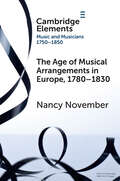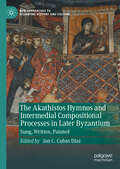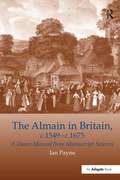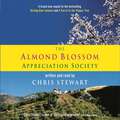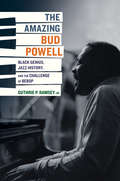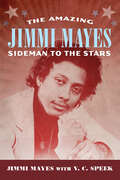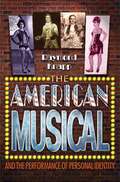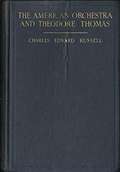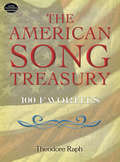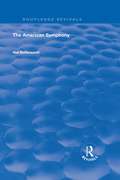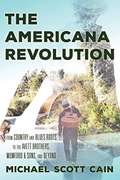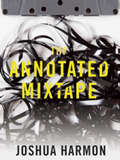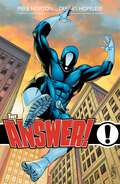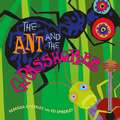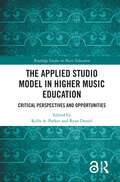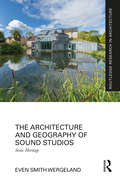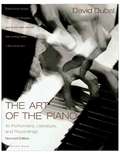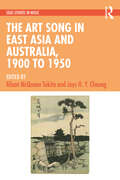- Table View
- List View
The Age of Musical Arrangements in Europe: 1780–1830 (Elements in Music and Musicians 1750–1850)
by Nancy NovemberThis Element considers the art and culture of arranging music in Europe in the period 1780–1830, using Haydn's London symphonies and Mozart's operas as its principal examples. The degree to which musical arrangements shaped the social, musical, and ideological landscape in this era deserves further attention. This Element focuses on Vienna, and an important era in the culture of arrangements in which they were widely and variously cultivated, and in which canon formation and the conception of musical works underwent crucial development. Piano transcriptions (for two hands, four hands, and two pianos) became ever more prominent, completely taking over the field after 1850. For various reasons, principal composers of the era under consideration, including Haydn, Mozart, and Beethoven, participated directly in the practice of arrangement. Motivations to produce arrangements included learning the art of composition, getting one's name known more widely, financial gain, and pedagogical aims.
The Agony of Modern Music
by Henry PleasantsMUSIC The Argument Modern music is not modern and is rarely music. # It represents an attempt to perpetuate a European musical tradition whose technical resources are exhausted, and which no longer has any cultural validity. # That it continues to be composed, performed, and discussed represents self-deception by an element of society which refuses to believe that this is true. # The hopelessness of the situation is technically demonstrable, and contemporary composers are aware of it. # What makes their own situation hopeless is that they cannot break with the tradition without renouncing the special status they enjoy as serious composers. # That they have this status is the result of a popular superstition that serious music is by definition superior to popular music. # There is good music, indifferent music and bad music, and they all exist in all types of composition. # There is more real creative musical talent in the music of Armstrong and Ellington, in the songs of Gershwin, Rodgers, Kern and Berlin, than in all the serious music composed since 1920. # New music which cannot excite the enthusiastic participation of the lay listener has no claim to his sympathy and indulgence. Contrary to popular belief, all the music which survives in the standard repertoire has met this condition in its own time. # The evolution of Western music continues in American popular music, which has found the way back to the basic musical elements of melody and rhythm, exploited in an original manner congenial to the society of which it is the spontaneous musical expression. # And it has found the way back to the basic musical nature of the ordinary mortal, from whom music derives, by whom and for whom it is produced, and without whom it cannot and does not exist.
The Akathistos Hymnos and Intermedial Compositional Processes in Later Byzantium: Sung, Written, Painted (New Approaches to Byzantine History and Culture)
by Jon C. Cubas DíazThis book explores intermedial compositional processes in later Byzantium, building on the Akathistos Hymnos. The relationship between the hymn’s text, music, and illustrations has yet to be explored in detail. The contributions here argue that these painted cycles should be studied as a result of interaction between hymnography, psalmody, and visual art, not just as mere illustration of text. Highlighting illuminated and notated manuscript copies of the hymn as evidence for varied liturgical and devotional practices, they examine how icons and murals based on the Akathistos functioned as constituent elements of sacred space. Focusing on intermediality, this book helps bridge methodological gaps between scholarly approaches to medieval culture.
The Akron Sound: The Heyday of the Midwest's Punk Capital
by Calvin C. RydbomMusic made in Akron symbolized an attitude more so than a singular sound. Crafted by kids hell-bent on not following their parents into the rubber plants, the music was an intentional antithesis of Top 40 radio. Call it punk or call it new wave, but in a short few years, major labels signed Chrissie Hynde, Devo, the Waitresses, Tin Huey, the Bizarros, the Rubber City Rebels and Rachel Sweet. They had their own bars, the Crypt and the Bank. They had their own label, Clone Records. They even had their own recording space, Bushflow Studios. London's Stiff Records released an Akron compilation album, and suddenly there were "Akron Nights" in London clubs and CBGB was waiving covers for people with Akron IDs. Author Calvin Rydbom of the "Akron Sound" Museum remembers that short time when the Rubber City was the place.
The Almain in Britain, c.1549-c.1675: A Dance Manual from Manuscript Sources
by Ian PayneThis complete scholarly edition of the collection of manuscript choreographies from c.1565-c.1675 associated with the Inns of Court is the first full-length study of these sources to be published. It offers practical reconstructions of the dances and provides a selection of musical settings simply but idiomatically arranged for four-part instrumental ensemble or keyboard. � Part One centres on the manuscript sources which transmit the Almain, and on the trends and influences that shaped its evolution in Britain from c. 1549 to c. 1675, taking account of both music and choreography.� In viewing the Almain within its broader historical context, Ian Payne throws new light on the dance, arguing that, together with the �measures� which accompany it in the choreographies, it owes an even greater debt to the English country dance than has hitherto been acknowledged, a popular style that received its fullest expression in Playford's English Dancing Master of 1651. � The second part of the book focuses on the dances themselves. The steps are described in detail and reconstructions provided for the nine Almains and some of the other measures included in the manuscripts. Part Three comprises a complete critical edition of the manuscripts. � These easily performable versions of the dances will be an invaluable aid to those wishing to learn the dances, reconstruct them for stagings of Shakespeare's plays or Jacobean masques, and for dance historians.
The Almond Blossom Appreciation Society
by Chris StewartThe good life abroad just keeps getting better as Christ Stewart, one-time Genesis drummer, turned sheepshearer, trned bestselling writer, returns with a new book on his life in the decidedly oddball region of Las Alpujarras, south of Granada.THE ALOMOND BLOSSOM APPRECIATION SOCIETY finds Chris and his family still living on their farm, El Varo - but life there never stands still. You will find yourself laughing out loud as Chris is instructed by his daughter on the way to treat dung beetles; bluffs his way as an art history guide to millionaire Bostonians; collects seeds in North Africa; and joins an Almond Blossom Appreciation Society. And you'll cringe as he tries his hand at office work in an immigrants' advice centre in Granada...In this sequel to DRIVING OVER LEMONS and A PARROT IN A PEPPER TREE, Chris Stewart's optimism and zest for life is as infectious as ever.Read by Chris Stewart(p) 2006 Orion Publishing Group
The Amazing Bud Powell
by Guthrie P. Ramsey Jr.Bud Powell was not only one of the greatest bebop pianists of all time, he stands as one of the twentieth century's most dynamic and fiercely adventurous musical minds. His expansive musicianship, riveting performances, and inventive compositions expanded the bebop idiom and pushed jazz musicians of all stripes to higher standards of performance. Yet Powell remains one of American music's most misunderstood figures, and the story of his exceptional talent is often overshadowed by his history of alcohol abuse, mental instability, and brutalization at the hands of white authorities. In this first extended study of the social significance of Powell's place in the American musical landscape, Guthrie P. Ramsey, Jr. shows how the pianist expanded his own artistic horizons and moved his chosen idiom into new realms. Illuminating and multi-layered, The Amazing Bud Powell centralizes Powell's contributions as it details the collision of two vibrant political economies: the discourses of art and the practice of blackness.
The Amazing Jimmi Mayes: Sideman to the Stars (American Made Music Series)
by Jimmi MayesAssociation of Recorded Sound Collections Awards for ExcellenceBest Research in Recorded Blues, Hip-Hop, Rhythm & Blues – Certificate of Merit (2014)For more than fifty years, Chicago drummer Jimmi Mayes served as a sideman behind some of the greatest musicians and musical groups in history. He began his career playing the blues in the juke joints of Mississippi, sharpened his trade under the mentorship of drum legends Sam Lay and Fred Below in the steamy nightclubs of south Chicago, and hit it big in New York City behind such music legends as Tommy Hunt from the Flamingos, Marvin Gaye, and James Brown.Mayes played his drums behind blues giants Little Walter Jacobs, Jimmy Reed, Robert Junior Lockwood, Earl Hooker, Junior Wells, Pinetop Perkins, and Willie "Big Eyes" Smith. He lived for a while with Motown sensation Martha Reeves and her family and traveled with the Shirelles and the Motown Review. Jimi Hendrix was one of Mayes's best friends, and they traveled together with Joey Dee and the Starliters in the mid-1960s.Mayes lived through racial segregation, the civil rights movement of the 1960s, the integration of rock bands, and the emergence of Motown. He personally experienced the sexual and moral revolutions of the sixties, was robbed of his musical royalties, and survived a musical drought. He's been a pimp and a drug pusher--and lived to tell the tale when so many musicians have not. This sideman to the stars witnessed music history from the best seat in the house--behind the drum set.
The American Musical and the Performance of Personal Identity: And the Performance of Personal Identity
by Raymond KnappThe American musical has long provided an important vehicle through which writers, performers, and audiences reimagine who they are and how they might best interact with the world around them. Musicals are especially good at this because they provide not only an opportunity for us to enact dramatic versions of alternative identities, but also the material for performing such alternatives in the real world, through songs and the characters and attitudes those songs project. This book addresses a variety of specific themes in musicals that serve this general function: fairy tale and fantasy, idealism and inspiration, gender and sexuality, and relationships, among others. It also considers three overlapping genres that are central, in quite different ways, to the projection of personal identity: operetta, movie musicals, and operatic musicals. Among the musicals discussed are Camelot, Candide; Chicago; Company; Evita; Gypsy; Into the Woods; Kiss Me, Kate; A Little Night Music; Man of La Mancha; Meet Me in St. Louis; The Merry Widow; Moulin Rouge; My Fair Lady; Passion; The Rocky Horror Picture Show; Singin' in the Rain; Stormy Weather; Sweeney Todd; and The Wizard of Oz. Complementing the author's earlier work, The American Musical and the Formation of National Identity, this book completes a two-volume thematic history of the genre, designed for general audiences and specialists alike.
The American Orchestra and Theodore Thomas
by Charles Edward RussellThe history of the American orchestra.<P><P> Pulitzer Prize Winner
The American Song Treasury: 100 Favorites
by Theodore Raph". . . besides innumerable good old tunes running in our heads, [there's] a sense of having actually lived in the years [covered by] this book." -- The International MusicianMusic has always played an important part in American life--from the hymns sung in colonial days, to partisan songs that supported independence, and war songs that boosted morale. Immigration, westward movement and industrialization all helped contribute to America's musical archives. This outstanding collection of 100 all-time favorite songs offers an unbeatable combination: the music and lyrics of well-known tunes in easy-to-sing keys, together with equally entertaining background information on each song. Assembled by noted composer, arranger and musical director Theodore Raph, this impressive volume spans 300 years--from the haunting strains of Greensleeves to songs that reached new peaks of popularity in the 1950s (He's Got the Whole World in His Hand).Perfect for party sing-alongs or for one's own enjoyment, these appealing songs all made past his parades. Yankee Doodle was "on the charts" during the Revolutionary War; Clementine and Sweet Betsy from Pike were widely hummed, sung, whistled and played in the mid-nineteenth century. She'll Be Comin' Round the Mountain and Wabash Cannonball heralded the era of transcontinental railroad construction; and regional songs such as My Old Kentucky Home, On the Banks of the Wabash, and Home on the Range became nationwide favorites.Easy-to-play piano accompaniments, guitar chords and complete lyrics make these familiar melodies ideal ice-breakers on picnics, boating excursions, camping trips and a host of other group activities. Because they're in the public domain, these tunes are also desirable for professional and commercial use. (No permission or royalty payments necessary!) Singers, pianists, students, teachers -- songsters at all levels of expertise -- will be delighted with these musical moments from bygone eras.
The American Symphony (Routledge Revivals)
by Neil ButterworthFirst published in 1998, this volume is the first book to focus on the American symphony. Neil Butterworth surveys the development of the symphony in the United States from early European influences in the last century to the present day, and asks why American composers have shown such allegiance to a musical form which their European contemporaries appear to have discarded. An overview of the growth of musical societies in America during the eighteenth century and the establishment of the first professional orchestras during the early part of the nineteenth century is followed by chronological analyses of the works of those composers who have played important parts in the progress of symphony in the United States, from Charles Ives, Aaron Copland and Leonard Bernstein, to contemporary figures such as William Bolcom and John Harbison. Complete with a comprehensive catalogue of symphonies and an extensive discography, this book is an indispensable reference work.
The Americana Revolution: From Country and Blues Roots to the Avett Brothers, Mumford and Sons, and Beyond (Roots of American Music: Folk, Americana, Blues, and Country)
by Michael Scott CainAmericana is a music that defies definition. It isn’t rock, although it does encompass rock. It isn’t folk, but folk is there. It isn’t Celtic, but it is woven with Celtic threads. It is a blend of forms, music that draws on a wide range of influences. Gathering these many genres together, Americana continually reinvents itself and actively tells the story of its origins and its future. <p><p> The Americana Revolution: From Country and Blues Roots to the Avett Brothers, Mumford & Sons, and Beyond is an informal social history that describes Americana as both a musical genre and a movement, showing what it is, where it came from, and where it is going. Musician and historian Michael Scott Cain examines how the idea of genre, especially Americana, affects the creation and consumption of music. He tries to discern the formulas of this slippery genre and seeks out the places where artists have broken or bent those formulas in the name of creativity. Through anecdotes and interviews, Cain provides a firsthand view into the creation of Americana to clarify how the genre can be categorized and defined. <p><p> Through the stories of its creators both long gone and new to the scene, Americana music comes alive as a diverse melting pot of creative genius. With this book, Cain grants music lovers from all backgrounds an unparalleled view into the future of a music that embraces new influences but never forgets its roots.
The Annotated Mixtape
by Joshua Harmon"Most of the time," Theodore Adorno has noted, "records are virtual photographs of their owners." The Annotated Mixtape is a memoir of record collecting, cross-fades music with personal history and American history and culture (the 2008 Recession, AM radio, Reaganomics, nuclear war) to show how the vinyl LP has shaped and informed the author's life.
The Answer! Volume 1
by Mike NortonInsomniac librarian Devin MacKenzie is yanked into a maelstrom of mayhem and mystery by the punctuation-faced crime fighter known as the Answer! Can this unlikely team take on the sinister BRAIN TRUST? A thoroughly original superhero adventure from Mike Norton (Battlepug) and Dennis Hopeless (Avengers Arena, Cable and X-Force). Collects the four-issue miniseries. * Dennis Hopeless (Cable and the X-Force, Avengers Arena) is one of comics' rising stars!
The Ant And The Grasshopper
by Ed Emberley Rebecca EmberleyWhile hard at work on her chores, an ant hears the wonderful clickety click chirrup of music coming from the distance. Although she knows she should focus on the task at hand, she can't help but explore the joyful noise! Award-winning team Rebecca and Ed Emberley bring an entertaining new twist to the classic children's. The bright, bold graphics seem to dance and leap, as a bunch of boogying bugs start a celebration of their own.
The Applied Studio Model in Higher Music Education: Critical Perspectives and Opportunities (Routledge Studies in Music Education)
by Kelly A. Parkes Ryan DanielThis book presents an examination of the applied music studio as part of higher education. Applied music studios are where students learn an instrument or voice in one-to-one settings with high-level musician teachers.This book reconceptualizes this teaching model within higher education, and it provides a critical lens, seated in current research provided by a diverse and highly influential set of researcher authors. It provides expert suggestions for improved teaching and learning practices in the applied music studio for readers who may be teachers themselves. It may also provide direction for leaders, directors, and department chairs who oversee the quality of applied music studio settings in the respective higher education units. The key feature of this book is that each chapter will explore new and relevant research, bringing new knowledge to the reader. Each chapter will also suggest relevant applied music studio practices and opportunities based on this targeted research literature.The primary audience for this book would be applied music studio teachers who engage in teaching within the applied music studio, offering suggestions for higher education and private teaching. A secondary audience would be music education researchers at all levels and who have an interest in contemporary thinking relevant to the applied music studio, as well as those interested in the master-apprentice format for learning in any field. Additionally, directors and chairs of music units globally in higher education would find this book helpful in guiding practice in the applied music studio within higher education settings.
The Architecture and Geography of Sound Studios: Sonic Heritage (Routledge Research in Architecture)
by Even Smith WergelandThis is a book about sound studios, focusing on their architectural and geographical aspects. It explores how music is materialized under specific spatial and technological conditions and the myths associated with this process.Through ten in-depth studies, it examines the design, evolution and current function of sound studios amidst economic and technological shifts in the music industry. Traditional studios are in flux between the past and future. The industry, while steeped in romanticism and nostalgia, also embraces forward-driven pragmatism and an extensive reuse culture, encompassing heritage audio, building materials and existing buildings. A surprisingly diverse architectural heritage, the most significant feature is the host building, the framework around the studio capsule. Many traditional studios adapt to digitalization with hybrid solutions, reflecting a shift toward smaller, more versatile spaces. In a time when recordings in theory can happen anywhere, destination studios must excel to attract clients, balancing historical legacies with diversification. Although they may be easy to deconstruct, many of the myths endure, sustaining ideas of landmark recordings, unique locations and distinct remnants of sonic heritage. Courtesy of their capacity to keep the past alive in the present, traditional sound studios are best described as museums that work.This book aims to reach scholars and students with an interest in history, theory and preservation, as well as practicing architects and architectural students who wish to find out more about the relationship between sound and space, acoustic design and retrofitting of historical buildings into specialized functions. It also aims to reach practicing musicians, producers, music students and music scholars.
The Arithmetic of Listening: Tuning Theory and History for the Impractical Musician
by Kyle GannTuning is the secret lens through which the history of music falls into focus, says Kyle Gann. Yet in Western circles, no other musical issue is so ignored, so taken for granted, so shoved into the corners of musical discourse.A classroom essential and an invaluable reference, The Arithmetic of Listening offers beginners the grounding in music theory necessary to find their own way into microtonality and the places it may take them. Moving from ancient Greece to the present, Kyle Gann delves into the infinite tunings available to any musician who feels straitjacketed by obedience to standardized Western European tuning. He introduces the concept of the harmonic series and demonstrates its relationship to equal-tempered and well-tempered tuning. He also explores recent experimental tuning models that exploit smaller intervals between pitches to create new sounds and harmonies.Systematic and accessible, The Arithmetic of Music provides a much-needed primer for the wide range of tuning systems that have informed Western music.
The Art Of The Piano: Its Performers, Literature And Recordings
by David DubalAlong with "careful judgement and genuine love of the subject" (Library Journal), David Dubal brings unparalleled expertise as a concert pianist, Juilliard faculty member, and former music director of a major classical music station to this second edition of his definitive guide to the piano. Here are enlightening profiles of history's greatest concert pianists from Clementi and Mozart to the major artists of the twentieth century. Here, too, in alphabetical order by composer, are the masterpieces of the literature, solo and concerto, a discussion of the place of each piece in the composer's oeuvre, and a list of recorded performances that "show the composition in its most diverse moods." Updated to include more than seventy additional pianists and hundreds of new CDs, this is a guide piano teachers, concert-goers, and other devotees of keyboard virtuosity should find "among the best read and most useful books on their personal reference shelves" (Booklist).
The Art Of The Song Recital
by Shirlee Emmons Stanley SonntagThe definitive work in its field! Since its original publication, the Emmons-Sonntag text has continually stood out as the definitive work on the song recital. The book presents imaginative advice and practical techniques for producing successful recitals and kindling audience excitement. Every aspect of the recital is covered, from building programs and the use of acting skills to the relationship between the singer and the accompanist. Singers of all levels and backgrounds will benefit from the authors' vast experience in the performance of song recitals as a singer/accompanist team. The comprehensive repertoire lists, now organized by voice and instrumentation as well as by composer, appeal to both students and professional musicians. Readers will agree that the authors have met their goal of providing "extensive, thoroughgoing, and definitive insights into the attributes that can render the song recital at once a great art and a magnificent entertainment."
The Art Of Tuning: A Self-guided Manual For Piano Tuning, Design, Action Regulation, And Repair From Mid-19th Century France
by Claude Montal Fred Sturm Paul Poletti Mario IgrecClaude Montal's THE ART OF TUNING is the first comprehensive text on piano tuning, construction, and repair ever written. Filled with historical details concerning the pianos of the mid-19th-century, The Art of Tuning documents the technology, tools, and techniques used during the most vibrant period in the development of the pianoforte. This translation by the piano technician and pianist Fred Sturm RPT masterfully preserves the direct and approachable style of the original.
The Art Song in East Asia and Australia, 1900 to 1950 (SOAS Studies in Music)
by Alison McQueen Tokita Joys H. Y. CheungThis book explores art song as an emblem of musical modernity in early twentieth-century East Asia and Australia. It appraises the lyrical power of art song – a solo song set to a poem in the local language in Western art music style accompanied by piano – as a vehicle for creating a localized musical identity, while embracing cosmopolitan visions. The study of art song reveals both the tension and the intimacy between cosmopolitanism and local politics and culture. In 20 essays, the book includes overviews of art song development written by scholars from each of the five locales of Japan, Korea, China, Taiwan, and Australia, reflecting perspectives of both established narratives and uncharted historiography. The Art Song in East Asia and Australia, 1900 to 1950 proposes listening to the songs of our neighbours across cultural and linguistic boundaries. Recognizing the colonial constraints experienced by art song composers, it hears trans-colonial expressions addressing musical modernity, both in earlier times and now. Readers of this volume will include musicologists, ethnomusicologists, singers, musicians, and researchers concerned with modernity in the fields of poetry and history, working within local, regional, and transnational contexts.
The Art Song in East Asia and Australia, 1900 to 1950 (SOAS Studies in Music)
by Alison McQueen Tokita and Joys H. Y. CheungThis book explores art song as an emblem of musical modernity in early twentieth-century East Asia and Australia. It appraises the lyrical power of art song – a solo song set to a poem in the local language in Western art music style accompanied by piano – as a vehicle for creating a localized musical identity, while embracing cosmopolitan visions. The study of art song reveals both the tension and the intimacy between cosmopolitanism and local politics and culture. In 20 essays, the book includes overviews of art song development written by scholars from each of the five locales of Japan, Korea, China, Taiwan, and Australia, reflecting perspectives of both established narratives and uncharted historiography. The Art Song in East Asia and Australia, 1900 to 1950 proposes listening to the songs of our neighbours across cultural and linguistic boundaries. Recognizing the colonial constraints experienced by art song composers, it hears trans-colonial expressions addressing musical modernity, both in earlier times and now. Readers of this volume will include musicologists, ethnomusicologists, singers, musicians, and researchers concerned with modernity in the fields of poetry and history, working within local, regional, and transnational contexts.
The Art Songs of Louise Talma (CMS Sourcebooks in American Music)
by Kendra Preston LeonardThe Art Songs of Louise Talma presents some of Talma’s finest compositions and those most frequently performed during her life. It includes pieces appropriate for beginning, intermediate, and advanced singers and collaborative pianists. The songs include text settings of American, English, and French poets and writers, including Native American poems, works by W. H. Auden, Elizabeth Barrett Browning, Emily Dickinson, e. e. cummings, John Donne, Gerald Manley Hopkins, William Shakespeare, and Wallace Stevens, as well as poems from medieval France and religious texts. Because of the popularity of Talma’s choral works and the fact that her works for voice and piano were performed often, this sourcebook will be useful to singers at all stages of their careers, as well as scholars of twentieth-century music as a whole. The diversity of compositional approaches Talma used provides a snapshot of American trends in composition during the twentieth century; during the course of her career, Talma moved from neo-classicism to serialism and finally to non-strict serial-derived atonality in her works. Inclusion of performance and reception histories of the songs helps trace changing public taste in American art song and the repertoire of performers, particularly those interested in contemporary music.
